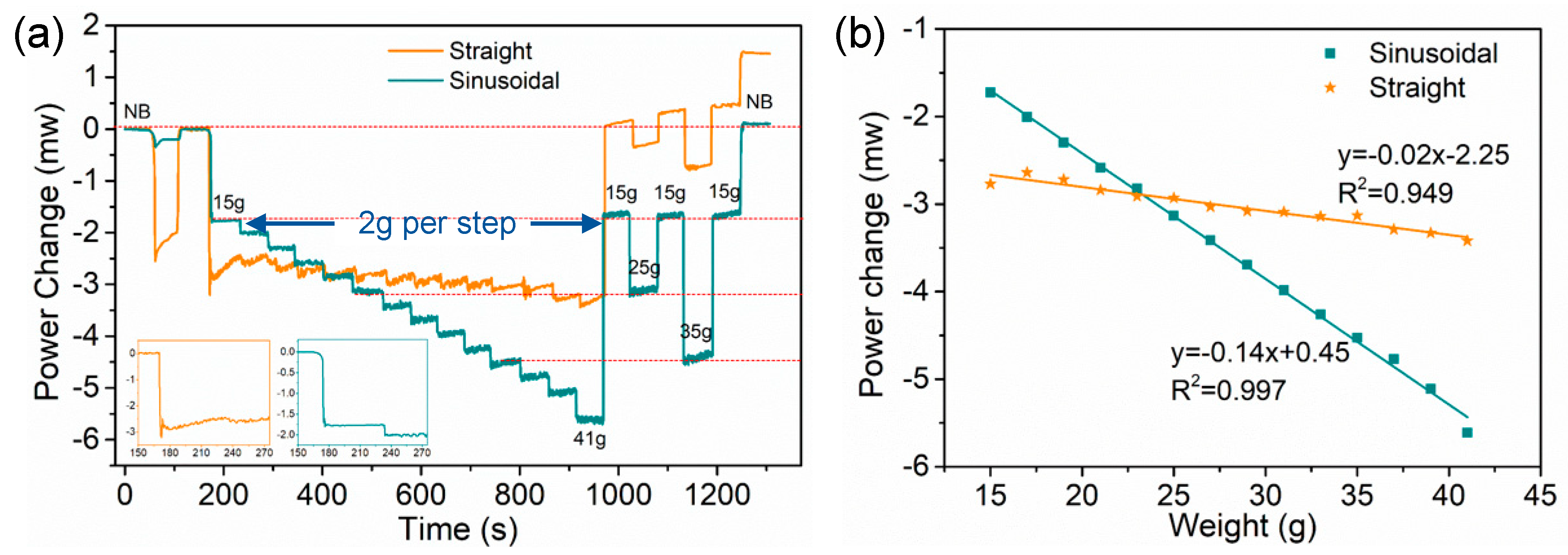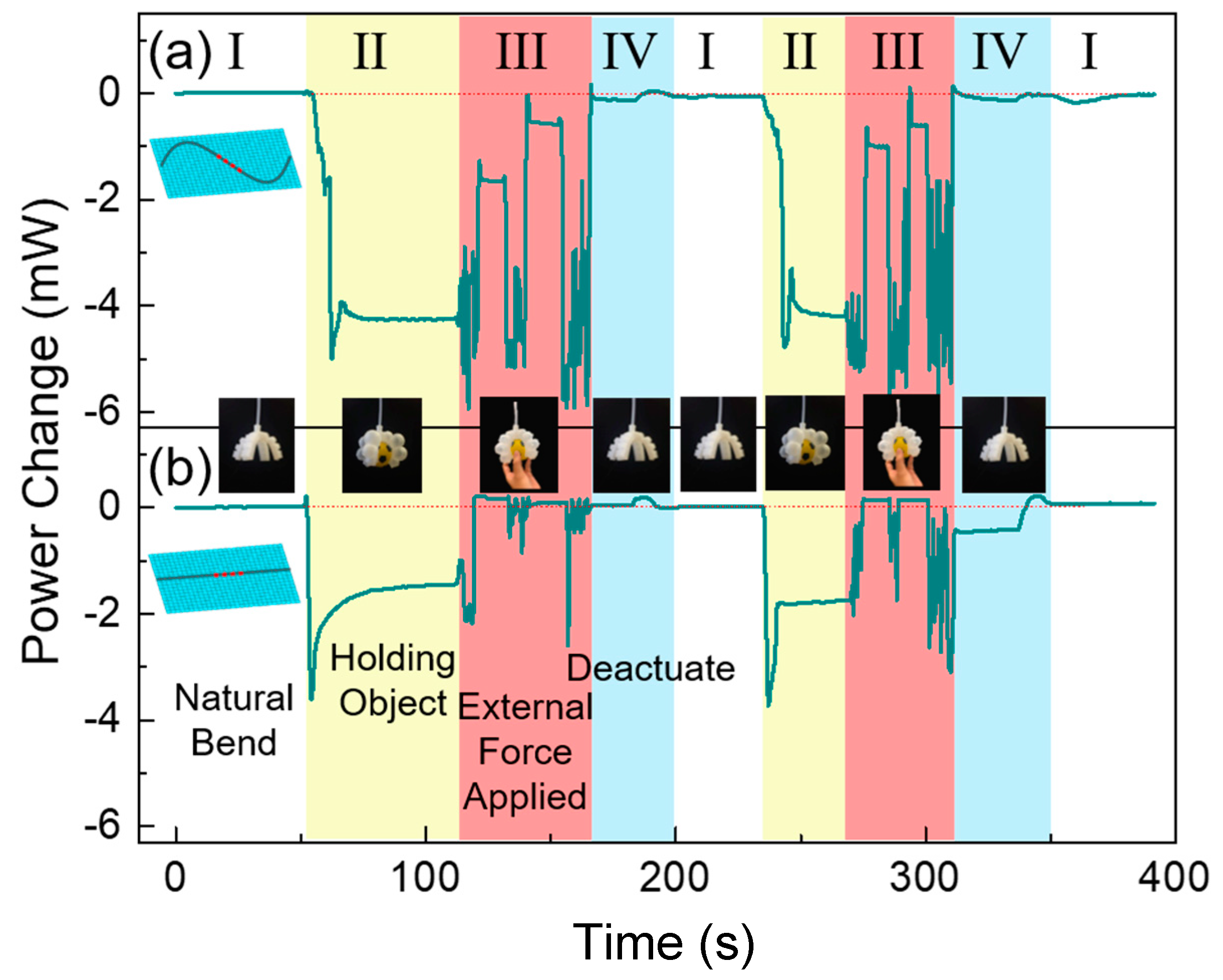Movement Detection in Soft Robotic Gripper Using Sinusoidally Embedded Fiber Optic Sensor
Abstract
:1. Introduction
2. Fabrication of the Sensor and Operation Principle
2.1. FBG Embedded Soft Robotic Sensor Fabrication
2.2. Sensing System
2.3. Sensing Principle
3. Experiment Results and Discussion
4. Conclusions
Author Contributions
Funding
Conflicts of Interest
References
- Bauer, S.; Bauer-Gogonea, S.; Graz, I.; Kaltenbrunner, M.; Keplinger, C.; Schwödiauer, R. 25th Anniversary Article: A Soft Future: From Robots and Sensor Skin to Energy Harvesters. Adv. Mater. 2013, 26, 149–162. [Google Scholar] [CrossRef] [PubMed] [Green Version]
- Wang, W.; Ahn, S.-H. Shape Memory Alloy-Based Soft Gripper with Variable Stiffness for Compliant and Effective Grasping. Soft Robot. 2017, 4, 379–389. [Google Scholar] [CrossRef] [PubMed]
- She, Y.; Li, C.; Cleary, J.; Su, H. Design and Fabrication of a Soft Robotic Hand With Embedded Actuators and Sensors. J. Mech. Robot. 2015, 7, 021007. [Google Scholar] [CrossRef]
- Jin, H.; Alici, G.; Mao, S.; Min, X.; Liu, C.; Low, K.H.; Dong, E.; Yang, J. A starfish robot based on soft and smart modular structure (SMS) actuated by SMA wires. Bioinspir. Biomim. 2016, 11, 56012. [Google Scholar] [CrossRef]
- Ratna, D.; Karger-Kocsis, J. Recent advances in shape memory polymers and composites: A review. J. Mater. Sci. 2007, 43, 254–269. [Google Scholar] [CrossRef]
- Truby, R.L.; Wehner, M.; Grosskopf, A.K.; Vogt, D.M.; Uzel, S.G.M.; Wood, R.J.; Lewis, J.A. Soft Somatosensitive Actuators via Embedded 3D Printing. Adv. Mater. 2018, 30, 1706383. [Google Scholar] [CrossRef] [Green Version]
- Pelrine, R. High-Speed Electrically Actuated Elastomers with Strain Greater Than 100%. Science 2000, 287, 836–839. [Google Scholar] [CrossRef]
- Park, Y.-L.; Chau, K.; Black, R.J.; Cutkosky, M.R. Force Sensing Robot Fingers using Embedded Fiber Bragg Grating Sensors and Shape Deposition Manufacturing. In Proceedings of the 2007 IEEE International Conference on Robotics and Automation, Roma, Italy, 10–14 April 2007; pp. 1510–1516. [Google Scholar]
- Martinez, R.; Branch, J.L.; Fish, C.; Jin, L.; Shepherd, R.F.; Nunes, R.M.D.; Suo, Z.; Whitesides, G.M. Composite Materials: Robotic Tentacles with Three-Dimensional Mobility Based on Flexible Elastomers. Adv. Mater. 2013, 25, 153. [Google Scholar] [CrossRef]
- Ilievski, F.; Mazzeo, A.D.; Shepherd, R.F.; Chen, X.; Whitesides, G.M. Soft robotics for chemists. Angew. Chem. Int. Ed. Engl. 2011, 50, 1890–1895. [Google Scholar] [CrossRef]
- Wang, H.; Zhang, R.; Chen, W.; Liang, X.; Pfeifer, R. Shape Detection Algorithm for Soft Manipulator Based on Fiber Bragg Gratings. IEEE/ASME Trans. Mech. 2016, 21, 2977–2982. [Google Scholar] [CrossRef]
- Fei, Y.; Wang, J.; Pang, W. A Novel Fabric-Based Versatile and Stiffness-Tunable Soft Gripper Integrating Soft Pneumatic Fingers and Wrist. Soft Rob. 2019, 6, 1–20. [Google Scholar] [CrossRef] [PubMed]
- Hao, Y.; Gong, Z.; Xie, Z.; Guan, S.; Yang, X.; Ren, Z.; Wang, T.; Wen, L. Universal soft pneumatic robotic gripper with variable effective length. In Proceedings of the 2016 35th Chinese Control Conference (CCC), Chengdu, China, 27–29 July 2016; pp. 6109–6114. [Google Scholar]
- Hao, Y.; Wang, T.; Ren, Z.; Gong, Z.; Wang, H.; Yang, X.; Guan, S.; Wen, L. Modeling and experiments of a soft robotic gripper in amphibious environments. Int. J. Adv. Robot. Syst. 2017, 14, 14. [Google Scholar] [CrossRef]
- Vogt, D.M.; Wood, R.J. Wrist angle measurements using soft sensors. In Proceedings of the IEEE SENSORS, Valencia, Spain, 2–5 November 2014; pp. 1631–1634. [Google Scholar]
- Jung, H.S.; Yang, S.Y.; Cho, K.H.; Song, M.G.; Nguyen, C.T.; Phung, H.; Kim, U.; Moon, H.; Koo, J.C.; Nam, J.-D.; et al. Design and fabrication of twisted monolithic dielectric elastomer actuator. Int. J. Control. Autom. Syst. 2017, 15, 25–35. [Google Scholar] [CrossRef]
- Selvan, N.; Eshwaran, S.; Das, A.; Stöckelhuber, K.W.; Wiesner, S.; Pötschke, P.; Nando, G.; Chervanyov, A.I.; Heinrich, G. Piezoresistive natural rubber-multiwall carbon nanotube nanocomposite for sensor applications. Sensors Actuators A: Phys. 2016, 239, 102–113. [Google Scholar] [CrossRef]
- Xu, L.; Ge, J.; Patel, J.H.; Fok, M. 3-Dimensional Soft Shape Sensor based on Dual-layer Orthogonal Fiber Bragg Grating Mesh. In Proceedings of the 2017 Optical Fiber Communications Conference and Exhibition (OFC), Los Angeles, CA, USA, 19–23 March 2017; pp. 1–3. [Google Scholar]
- Jiang, L.; Low, K.; Costa, J.; Black, R.J.; Park, Y.-L. Fiber optically sensorized multi-fingered robotic hand. In Proceedings of the 2015 IEEE/RSJ International Conference on Intelligent Robots and Systems (IROS), Hamburg, Germany, 28 September–2 October 2015; pp. 1763–1768. [Google Scholar]
- Ge, J.; James, A.; Xu, L.; Chen, Y.; Kwok, K.-W.; Fok, M. Bidirectional Soft Silicone Curvature Sensor Based on Off-Centered Embedded Fiber Bragg Grating. IEEE Photon. Technol. Lett. 2016, 28, 2237–2240. [Google Scholar] [CrossRef]
- Leal-Junior, A.G.; Theodosiou, A.; Frizera, A.; Pontes, M.J.; Shafir, E.; Palchik, O.; Tal, N.; Zilberman, S.; Berkovic, G.; Antunes, P.; et al. Characterization of a new polymer optical fiber with enhanced sensing capabilities using a Bragg grating. Opt. Lett. 2018, 43, 4799–4802. [Google Scholar] [CrossRef]
- Broadway, C.; Min, R.; Leal-Junior, A.G.; Marques, C.; Caucheteur, C.; Rui, M. Toward Commercial Polymer Fiber Bragg Grating Sensors: Review and Applications. J. Light. Technol. 2018, 37, 2605–2615. [Google Scholar] [CrossRef]
- Wang, Y.; Gregory, C.; Minor, M.A. Improving Mechanical Properties of Molded Silicone Rubber for Soft Robotics Through Fabric Compositing. Soft Robot. 2018, 5, 272–290. [Google Scholar] [CrossRef]
- Zhao, H.; O’Brien, K.; Li, S.; Shepherd, R.F. Optoelectronically innervated soft prosthetic hand via stretchable optical waveguides. Sci. Robot. 2016, 1, eaai7529. [Google Scholar] [CrossRef] [Green Version]
- To, C.; Hellebrekers, T.L.; Park, Y.-L. Highly stretchable optical sensors for pressure, strain, and curvature measurement. In Proceedings of the 2015 IEEE/RSJ International Conference on Intelligent Robots and Systems (IROS), Hamburg, Germany, 28 September–2 October 2015; pp. 5898–5903. [Google Scholar]
- Xu, L.; Ge, J.; Patel, J.H.; Fok, M.P. Dual-layer orthogonal fiber Bragg grating mesh based soft sensor for 3-dimensional shape sensing. Opt. Express 2017, 25, 24727. [Google Scholar]
- Liu, H.; Farvardin, A.; Pedram, S.A.; Iordachita, I.; Taylor, R.H.; Armand, M. Large deflection shape sensing of a continuum manipulator for minimally-invasive surgery. In Proceedings of the 2015 IEEE International Conference on Robotics and Automation (ICRA), Seattle, WA, USA, 26–30 May 2015; Volume 2015, pp. 201–206. [Google Scholar]
- Sefati, S.; Alambeigi, F.; Iordachita, I.; Murphy, R.; Armand, M. FBG-based large deflection shape sensing of a continuum manipulator: Manufacturing optimization. In Proceedings of the 2016 IEEE SENSORS, Orlando, FL, USA, 30 October–3 November 2016; pp. 1–3. [Google Scholar]
- Rahman, N.; Deaton, N.J.; Sheng, J.; Cheng, S.S.; Desai, J.P. Modular FBG Bending Sensor for Continuum Neurosurgical Robot. IEEE Robot. Autom. Lett. 2019, 4, 1424–1430. [Google Scholar] [CrossRef] [PubMed]
- Xu, L.; Liu, N.; Ge, J.; Wang, X.; Fok, M. Stretchable fiber-Bragg-grating-based sensor. Opt. Lett. 2018, 43, 2503–2506. [Google Scholar] [CrossRef] [PubMed]
- Xu, L.; Liu, N.; Ge, J.; Wang, X.; Fok, M.P. Stretchable multi-function fiber sensor for tension, bending and torsion sensing. In Proceedings of the 2018 Optical Fiber Communications Conference and Exposition (OFC), San Diego, CA, USA, 11–15 March 2018; p. W1K.5. [Google Scholar]







| Wavelength Shift (nm) | |||
|---|---|---|---|
| Position I (green) 3/4 of arm length | Position II (blue) 1/2 of arm length | Position III (gray) 1/4 of arm length | |
| Actuated-no object | 0.3025 | 0.1663 | 0.0345 |
| Actuated-15g sphere | 0.3262 | 0.2287 | 0.0459 |
| Actuated-25g sphere | 0.3297 | 0.2095 | 0.0635 |
| Actuated-35g sphere | 0.3449 | 0.2211 | 0.0802 |
| Deactuated | 0 | 0 | 0 |
| Wavelength Shift (nm) | |||
|---|---|---|---|
| Period I (green) ω = 0.5 | Period II (blue) ω = 1 | Period III (gray) ω = 2 | |
| Actuated-no object | 0.1472 | 0.0382 | 0.0207 |
| Actuated-15g sphere | 0.1661 | 0.0507 | 0.0276 |
| Actuated-25g sphere | 0.1747 | 0.0627 | 0.0352 |
| Actuated-35g sphere | 0.1825 | 0.0822 | 0.0394 |
| Deactuated | 0 | 0 | 0 |
| Event | Condition | Power Change Magnitude | Power Change Pattern |
|---|---|---|---|
| Actuation | Holding an object | Large (>1.5 mW) | Instantaneously |
| Failed to hold an object | Small (<0.5 mW) | Instantaneously | |
| Fail to actuate (air is leaking) | No change | No change | |
| External perturbation | Weak | Large, with small fluctuation (+/−1 mW) | Fluctuate within a small power range then stabilize at a similar power as before perturbation |
| Object position is changed | Small, with large fluctuation (+/−2 mW) | Fluctuate within a large power range then stabilized at a smaller power change value | |
| Object is lost | Small | Power return to a value that is close to natural bending position | |
| Deactuation | Deflated | No change | Slightly overshoot and stabilized at natural bending value |
| Sinusoidal | Straight | |
|---|---|---|
| Sensitivity | 0.14 mW/g | 0.02 mW/g |
| Stretchable | Yes | No |
| Delamination | No | Significant |
| Repeatability | Good (>50 times) | Poor |
| Response time | <0.5 s | 0.5–2.5 s |
| Stabilization time | Instantaneous | >60 s |
© 2020 by the authors. Licensee MDPI, Basel, Switzerland. This article is an open access article distributed under the terms and conditions of the Creative Commons Attribution (CC BY) license (http://creativecommons.org/licenses/by/4.0/).
Share and Cite
Yang, M.; Liu, Q.; Naqawe, H.S.; Fok, M.P. Movement Detection in Soft Robotic Gripper Using Sinusoidally Embedded Fiber Optic Sensor. Sensors 2020, 20, 1312. https://doi.org/10.3390/s20051312
Yang M, Liu Q, Naqawe HS, Fok MP. Movement Detection in Soft Robotic Gripper Using Sinusoidally Embedded Fiber Optic Sensor. Sensors. 2020; 20(5):1312. https://doi.org/10.3390/s20051312
Chicago/Turabian StyleYang, Mei, Qidi Liu, Hamza Sayed Naqawe, and Mable P. Fok. 2020. "Movement Detection in Soft Robotic Gripper Using Sinusoidally Embedded Fiber Optic Sensor" Sensors 20, no. 5: 1312. https://doi.org/10.3390/s20051312





